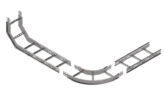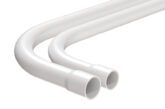
Martin Gregg, Commercial Manager at Unitrunk asks why there are no regulations for fire testing of cable management within the electrical industry.
While fire safety has always been embedded into the design and construction of buildings through various standards and legislative controls, the events that took place at Grenfell Tower almost two years ago have, quite rightly, become a focus for examining the suitability of certain materials for use in construction or refurbishment projects. There is widespread consensus on the need for positive change.
Some legislative change has already started to happen, with certain types of ‘combustible’ cladding materials now banned on new build residential buildings taller than 18m high. It’s a start, but even this step towards learning direct lessons from Grenfell has been criticised, because high rise hotel and office buildings are exempt from the ban and the use of combustible materials for the building envelope of low rise properties remains a risk to those who live there.
The Hackitt Report, published last May following the independent review of building regulations and fire safety, highlighted the ‘ambiguity of regulations and guidance’ and called for a ‘risk-based approach’ to specification with ‘transparency of information and an audit trail’. The report acknowledges that ‘legislative change will take time’ but the question remains, why do we not already have a suitable regulatory framework in place for electrical fire safety? Moreover, with such lack of clarity, where can the industry turn for reassurance that the jobs they are specifying now will be both safe and compliant when any future legislation comes into force?
Ambiguity
As many who have worked in the construction or electrical sector overseas will tell you, the UK industry has regulatory requirements that are more robust than most other countries. Our building regulations and fire regulations are seen internationally as very demanding and the wiring regulations are now in their 18th edition, covering a broad spectrum of electrical safety. However, despite the fact that the latest wiring regulations were clearly influenced by the need to respond to fire safety concerns prompted by Grenfell, there is still nothing within the 18th edition that stipulates fire testing of cable management; the backbone of any commercial electrical installation and the physical barrier between electrical cables and the building fabric.
Cable management is just one of the many product categories for which there is currently no mandatory fire testing requirement, either within building regulations or wiring regulations. This leaves those with responsibility for specifying and installing cable management networks with a lack of information regarding which systems offer verified fire safety: the very ‘ambiguity’ criticised in the Hackitt Report.
Despite the fact that the source of the fire at Grenfell Tower has been traced to an electrical fault, it is building envelope materials that have come under scrutiny in the wake of the disaster, rather than materials essential to the installation of building services. While we might speculate that this is due to an assumption that electrical installations carry an inherent level of fire risk – after all, more than half of fires in domestic properties are caused by electricity (Source: Electrical Safety First – 54.4% of fires in England are caused by electricity) – this is surely an argument for considering where fire safety in the specification of electrical installation materials can be improved?
Safer future
The programme of legislative change following the publication of the Hackitt Report has only just begun and there are certain to be more changes in mandatory standards and permissible materials still to come. So far, however, there seems to be scant attention to the fire safety of cable management systems, which is why Unitrunk has invested in independent fire safety testing for both our cable tray and cable ladder systems, ahead of any industry requirement. For us, there may be no regulation on fire resilience but there is a moral obligation to ensure resilience is built into the design and manufacture of our products and to verify it through independent testing.
Thanks to the testing, we are also now able to offer specifiers, contractors and their clients the peace of mind that comes with knowing that both our UniKlip and standard cable management systems have achieved an E90 rating, which means the cables within the system could power a lamp continuously for at least 90 minutes at a temperature of 10000C – a temperature comparable to a building fire. We’re the first cable management system specialist in the UK to pass these tests and we’re now calling on the rest of the industry to do the same.
For so many of us, the images of the tower of flames at Grenfell and the TV footage of distressed and bereaved residents will remain vivid for years to come. There is nothing we can do now to prevent that loss of life or devastation but we have a moral obligation to do everything we can to ensure buildings are safer in the future. Verifying the fire safety of the materials we use is an integral part of that obligation and, hopefully, it will also become a regulatory requirement one of these days, creating a corresponding commercial imperative to test for fire safety.
For more information about the range of cable management solutions available from Unitrunk visit: www.unitrunk.co.uk








